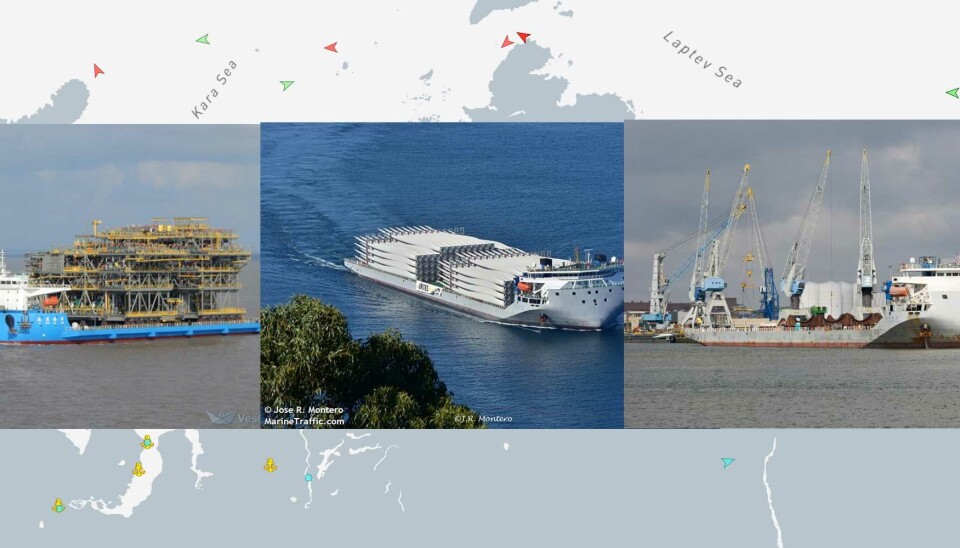Chinese heavy lift ship without ice-class battles on freezing Arctic route
Sea-ice is quickly expanding across the region as 154 meter long carrier Ocean 28 makes it across the Northern Sea Route with sanctioned goods for Russia’s crisis-ridden Arctic LNG 2 project.

The Ocean 28 set out from the Chinese port of Zhangjiagang on 24 September and is due to reach its destination on 30 October. Ship tracking services first indicated that the vessel was heading to a Norwegian port. But it is now clear that the Chinese vessel that sails under Panama flag is on the way to the port of Utrenny.
According to MarineTraffic, the Ocean 28 is due to arrive at the site of the Arctic LNG 2 project on the 30 October. However, according to data from the Northern Sea Route Administration, the ship was on 29 October still located in the Laptev Sea.
Judging from information from the Russian state managing authority for the sea route, the Ocean 28 has no ice-class. Nevertheless, it has permission for sailing in the remote and icy region until 15 November.
The heavy lift ship is only one of many vessels without ice-class that this fall has been granted permission to sail through the remote Arctic waters.
The permission granted by the NSR Administration states that the ship needs escort from icebreakers “in ice free water and in light type of ice conditions.”
However, judging from information from the NSR Administration, there was all through October only one nuclear powered icebreaker that operated along the easter part of the Northern Sea Route. All through fall, the Sibir has been busy with icebreaking in the area. The situation has been especially difficult in the Chukchi Sea where a belt of multi-year old sea-ice has obstructed shipments.

Several ship captains that recently sailed on the Northern Sea Route report that conditions are getting increasingly difficult. Among them is Stanislav Varik, Commander of the Russian Navy flotilla that this fall was on a major expedition in the area. A high level of sea-ice surveillance was needed, and the ships were assisted by capacities provided by Rosatom, he said upon return to base in Severomorsk in mid-October.
Also Rosatom in late October issued a warning that sea-ice is quickly generating in the Laptev Sea.
The Ocean 28 was built in 2022. It is managed by a company named the Hong Kong Yaquing Shipping Co. The ship has a deadweight of 24,623 tons and is classified as a deck cargo vessel.
It is not the only ship of the kind that now is on the way to the Ob Bay. Heavy lift carrier Nan Feng Zhi Xing and the Hunter Star are scheduled to arrive on site on the 30 October and 6 November respectively. Neither of the vessels are made for shipping in the ice. They both have ice-class Ice1, which is far below what is required for Arctic waters.
Details about the cargo onboard the three heavy lift carriers are not clear, but according to Russian media they carry power generation modules for the LNG project.
The Arctic LNG 2 project has been paralysed by the international sanctions imposed on Russia following the war of aggression against Ukraine. The two LNG production units that now are located at Utrenny risk ending up as rusting ghost objects.
There is growing concern for security in the remote Russian Arctic waters as Moscow clearly has lowered requirements for ships operating in the area.
A Norwegian expert says Russia now is compromising security in the remote Arctic waters.
According to Norvald Kjerstad, Professor in nautical science at the Norwegian University of Science and Technology (NTNU), shipping companies in the area now take big risks.
“It seems like the Russians now completely ignore the security requirements that used to be normal,” he said in a comment to the Barents Observer.
It is only three years since a rapid and unexpected freeze of the sea-ice led to a serious crisis on the Northern Sea Route. In early November 2021, more than 20 ships got stuck in the ice and it took several weeks to get out all the captured sailors and ships.
Located in Kirkenes, Norway, just a few kilometres from the borders to Russia and Finland, the Barents Observer is dedicated to cross-border journalism in Scandinavia, Russia and the wider Arctic.
As a non-profit stock company that is fully owned by its reporters, its editorial decisions are free of regional, national or private-sector influence. It has been a partner to ABJ and its predecessors since 2016.